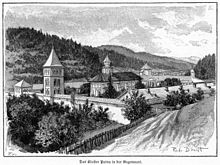Putna Monastery

The Putna monastery located in Romania , around 72 kilometers from the city of Suceava removed. Today it belongs to a group of Romanian Orthodox monasteries - the Moldavian monasteries - in southern Bukovina , in the past they were Greek Orthodox monasteries.
history
According to a legend of the historian Ion Neculce, Stefan the Great shot an arrow from a mountain into the nearby Carpathian Valley in 1466 before the monastery was founded . The prince decided to build an altar on the spot where his arrow got stuck.
Then Prince Stefan had the monastery built between 1466 and 1469. The monastery was consecrated on September 3, 1470. Putna Monastery was then a thriving cultural center. Clergy and chroniclers from the region were trained there between the 15th and 16th centuries. Monks copied manuscripts and old chronicles and adorned religious texts with miniatures.
The old monastery church was destroyed in 1653 and rebuilt between 1653 and 1662 - during the reigns of Vasile Lupus, Gheorghe Stefans and Eustratie Dabijas - without the frescoes on the outside. It has been preserved in this form to this day, although it was damaged again in 1757. In the same year a comprehensive reconstruction of the buildings took place under the direction of Metropolitan Jakob. For the dilapidated tower on the west side, a new tower was built at the gate, which was consecrated in 1885.
The tombstone of Stephen the Great is in the monastery cemetery. The prince has been buried there since 1504, as has his second wife, Maria von Mangop and his third wife Maria Voichita. In the immediate vicinity are the graves of some of the descendants of Stefan, of Moldovan bishops who contributed to the care and maintenance of the monasteries, and of the Holy Hierarch Ilie Iorest.
Many valuable manuscripts, maps, paintings, icons, linen cloths and other ecclesiastical objects dating back to the 15th century are kept in the monastery museum. Worth mentioning are the self-portrait of Stefan's second wife Maria von Mangop and the skull of Saint Ghenadie.
There are some even older hermitages in the vicinity of the monastery. The most important one is called Chilie în piatră and is a site carved into the rock. It has the complete structure of a Greek church with the sections pronaos , naos and sanctuary .
Monastery economy
Putna Monastery had the most extensive manorial property in Bukovina. These included lands and businesses in an area between Chernivtsi and the Transylvanian border.
In the vicinity of Putna Monastery, as in other regions of the Carpathian Mountains, there was lively forest management. For this purpose, great efforts were made, especially in the 19th century, to set up sawmills, rafting systems and forest railways. The latter were used to transport the felled timber to a nearby sawmill or to individual timber collection and rafting stations.
There was significant wood processing in the Putna Monastery area. It was there that the first processing of the round wood that was felled on the slopes of the Dealul Oglinda, Poiana Crucii and Poiana Haciungului mountains.
The business operations run by the Bukovinian Greek-Oriental Religious Fund (established by decree of April 29, 1786) were an important part of the financing of religious institutions in the crown land of Bukovina and offered a variety of employment opportunities in a predominantly structurally poor region.
The regional logging areas were of great importance for the procurement of construction timber. On the Suceava River, which flows by not far from the monastery, rafting was carried out between 1820 and 1860. This had to be stopped because of flood damage.
literature
- Dimitri E. Conomos: The Monastery of Putna and the Musical Tradition of Moldavia in the Sixteenth Century. In: Dumbarton Oaks Papers, Vol. 36, 1982, pp. 15-28
- Archduke Rudolf (ed.): The Austro-Hungarian monarchy in words and pictures. (Bukowina, Volume 20) Verlag der kk Hof- und Staatsdruckerei, Vienna 1899 ( online )
Web links
- Putna (Eng.)
- Putna Monastery (Rum.)
Individual evidence
- ↑ Putna Monastery ( Memento of the original from April 23, 2008 in the Internet Archive ) Info: The archive link was inserted automatically and has not yet been checked. Please check the original and archive link according to the instructions and then remove this notice.
- ↑ Putna Monastery ( Memento of the original from January 9, 2009 in the Internet Archive ) Info: The archive link was automatically inserted and not yet checked. Please check the original and archive link according to the instructions and then remove this notice.
Coordinates: 47 ° 51 ′ 45 ″ N , 25 ° 36 ′ 19 ″ E



